Allentown, Pennsylvania – Sunday, June 8th, 2008
We arrived at Dorney Park just about at the park opening. As soon as we had our Platinum Passes scanned we got straight to business and headed directly to Voodoo before the lines became longer than it was worth. Voodoo looks alright for the park. It fits in well, completing the ‘four corners’ with Talon, Hydra and Steel Force being the major pulls at other corners of the park and with the ‘original’, classic, nicely landscaped part of the park in the center of it all. Dorney is a park often dismissed as a bland and overly corporatized park, and while that is mostly true (especially being in a state with so many quirky, family owned parks nearby), that perception may also be a symptom of the coaster enthusiasts spending all their time along the periphery of the park where the newer coasters have been plopped down and never venturing into the center which has parts that could compare to a Kennywood or what-have-you in terms of aesthetic qualities, parts that have yet to be ‘modernized’ by Cedar Fair’s standards.
of the park where the newer coasters have been plopped down and never venturing into the center which has parts that could compare to a Kennywood or what-have-you in terms of aesthetic qualities, parts that have yet to be ‘modernized’ by Cedar Fair’s standards.
In any event, Voodoo – nice sign and logo, not so nice queue line, sitting right next to the parking lot with absolutely no shade whatsoever. Thankfully there was still a walk-on wait when we got there, and opted for the back row since the back tower is the main thing that’s ‘new’ to me (at least since a 2004 visit to Geauga Lake) compared to Wicked Twister. It’s okay, I kind of like the brake but it only really works when you’re in the back and get to have a decent sense of vertigo, and overall lack of a twist and smaller stature make it not as good as Wicked Twister.
is the main thing that’s ‘new’ to me (at least since a 2004 visit to Geauga Lake) compared to Wicked Twister. It’s okay, I kind of like the brake but it only really works when you’re in the back and get to have a decent sense of vertigo, and overall lack of a twist and smaller stature make it not as good as Wicked Twister. Since there was still a small line I think we went around twice more, once in some random middle seat with no extra wait, and the last time in the very front which had about a five-cycle wait which I was fine with since I figured this to be all the rides I’d be getting on this throughout the day. The front’s always cool on these things because you can watch the heartlined track twist around you on the way up the spike,
Since there was still a small line I think we went around twice more, once in some random middle seat with no extra wait, and the last time in the very front which had about a five-cycle wait which I was fine with since I figured this to be all the rides I’d be getting on this throughout the day. The front’s always cool on these things because you can watch the heartlined track twist around you on the way up the spike,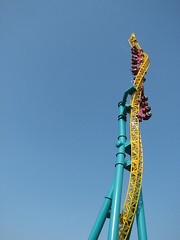 but be careful on the time of day you ride because otherwise you might be staring directly into the sun on your way up. Overall these impulse coasters don’t do too much for me, I generally enjoy them well enough while I’m on them but then there’s this deflationary effect after it’s over that the whole experience just didn’t
but be careful on the time of day you ride because otherwise you might be staring directly into the sun on your way up. Overall these impulse coasters don’t do too much for me, I generally enjoy them well enough while I’m on them but then there’s this deflationary effect after it’s over that the whole experience just didn’t seem to amount to very much in the end. This would be only year it was known as Voodoo, apparently for some copyright reasons they were forced to change it to “Possessed” the following season. Apart from finding some vague ironic humor in the reasoning for all of this, I’m indifferent to the name change.
seem to amount to very much in the end. This would be only year it was known as Voodoo, apparently for some copyright reasons they were forced to change it to “Possessed” the following season. Apart from finding some vague ironic humor in the reasoning for all of this, I’m indifferent to the name change.
Just beyond Voodoo was Laser,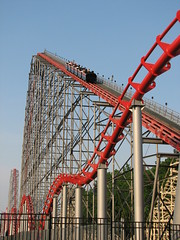 though unfortunately it was closed, in fact I think there was a small crane or some sort of construction equipment in the structure, so I figured that one would be down and out for the day. Instead we headed up to do Steel Force, which with its high-capacity trains I figured would still have walk-on lines at this time of day. There was a bit more of a crowd than I expected, especially for the front car, but it was still easy to find a couple of walk-on rows near the back of the train. The track and supports immediately around the Steel Force plaza had been freshly painted, but beyond the lift hill it was still the old paint, which in places was not only faded but also very splotchy and ugly, hopefully they finish the job for next season.
though unfortunately it was closed, in fact I think there was a small crane or some sort of construction equipment in the structure, so I figured that one would be down and out for the day. Instead we headed up to do Steel Force, which with its high-capacity trains I figured would still have walk-on lines at this time of day. There was a bit more of a crowd than I expected, especially for the front car, but it was still easy to find a couple of walk-on rows near the back of the train. The track and supports immediately around the Steel Force plaza had been freshly painted, but beyond the lift hill it was still the old paint, which in places was not only faded but also very splotchy and ugly, hopefully they finish the job for next season.
Steel Force is often compared to Magnum, but as a long-time Magnum purist I find such comparisons superficially shallow at best. That said the strong resemblance probably is because Kinzel wanted an exact copy of Magnum built for Dorney Park. If Arrow were still doing good business in the mid/late 90’s I think it’s possible we would have ended up with a clone. Steel Force suffers a bit from these comparisons to other hyper coasters as there isn’t the sense that anything new is to be found here, but remember before B&M and Intamin started building their own megacoasters Steel Force was once ranked as one of the top ten if not top five steel rides on the planet; it surprisingly still ranks among the top five longest steel coasters in North America (5600’), so you’re at least getting your money’s worth once you board the boxy, high-walled trains.
of Magnum built for Dorney Park. If Arrow were still doing good business in the mid/late 90’s I think it’s possible we would have ended up with a clone. Steel Force suffers a bit from these comparisons to other hyper coasters as there isn’t the sense that anything new is to be found here, but remember before B&M and Intamin started building their own megacoasters Steel Force was once ranked as one of the top ten if not top five steel rides on the planet; it surprisingly still ranks among the top five longest steel coasters in North America (5600’), so you’re at least getting your money’s worth once you board the boxy, high-walled trains.
The good news is that while expectations and tastes have changed, Steel Force is still about as good as it always has been.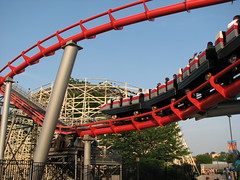 The first two hills are predictably parabolic but that doesn’t mean that can’t still be enjoyable. It doesn’t lose interest after the first couple of hills nearly as much as the other purebred Morgan hypercoasters do when the height and speed become compromised. The turnaround maintains a very good sense of speed thanks to the low banking and the low-to-the-ground use of terrain, and then every hill on the way back gives a gentle but still very solid boost upwards that even increase a bit with intensity over each progressive hill, ending with the double-pop on the final hill. All told it’s still my favorite roller coaster in Allentown, and there are some other good ones around. The main thing I was disappointed in was I remember the speed and height on Mamba’s first few hills when I rode that one last in 2006 were quite significant, with wind in the front
The first two hills are predictably parabolic but that doesn’t mean that can’t still be enjoyable. It doesn’t lose interest after the first couple of hills nearly as much as the other purebred Morgan hypercoasters do when the height and speed become compromised. The turnaround maintains a very good sense of speed thanks to the low banking and the low-to-the-ground use of terrain, and then every hill on the way back gives a gentle but still very solid boost upwards that even increase a bit with intensity over each progressive hill, ending with the double-pop on the final hill. All told it’s still my favorite roller coaster in Allentown, and there are some other good ones around. The main thing I was disappointed in was I remember the speed and height on Mamba’s first few hills when I rode that one last in 2006 were quite significant, with wind in the front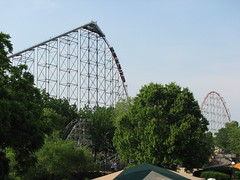 seat that made the tears roll back the side of your face, and that was all missing from Steel Force’s first hills despite the similarity in size (perhaps because Steel Force is in a valley while Mamba is on a hill).
seat that made the tears roll back the side of your face, and that was all missing from Steel Force’s first hills despite the similarity in size (perhaps because Steel Force is in a valley while Mamba is on a hill).
After about four rides on Steel Force we started wandering back towards the main entrance, the heat becoming very strong. I had talked to CoasterSim’s Tyrant prior to the trip, who told me he’d be in the area and would try to stop by and meet up at Dorney. Since I hadn’t heard anything, I decided to give him a call, and unfortunately he wasn’t feeling too well and wouldn’t be able to make it after all. My dad and I sat around drinking ice waters for a while trying to figure out how to pace the day considering the heat, and decided to slowly make our way over to Talon.
I never really have Talon on my radar as an exceptional B&M because the layout is a little too familiar, the compact, built-over-gravel, main midway setting recalls too readily a smaller, inferior version of Raptor. It’s a double-edged sword seeing as Magnum and Raptor are very good rides to copy off of, and indeed I had to be reminded today that Talon possibly is more successful than many other B&M inverted coasters with ‘original’ layouts. The first three inversions are a pretty rockin’ sequence (I like the trench before the Immelmann), and it then slows the pace down for a breezy, soaring middle act consisting of an inclined helix and elevated s-turn before diving in for the kill with a final drop, corkscrew and helix into the brakes. This is pretty much the same progression I praise Raptor so much for, only stripped of several extra elements and without as strong a finish.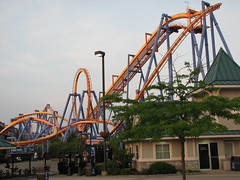
That said Talon wasn’t as good as I remembered it from 2003. Back then I recalled all these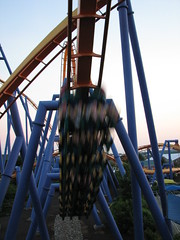 little pops of airtime scattered throughout the ride that really defined the coaster over other B&M inverts, coloring the experience with a wider palate of force than I’m normally accustomed to from this genre, besides simply making it more fun. Now, while they were still partly present, what
little pops of airtime scattered throughout the ride that really defined the coaster over other B&M inverts, coloring the experience with a wider palate of force than I’m normally accustomed to from this genre, besides simply making it more fun. Now, while they were still partly present, what I mostly remember is a consistently strong positive G-force ride. I still like Talon a lot better than Patriot, which I felt the more spread-out layout of the same series of elements left the ride with a much looser pacing that just made it pretty bland in the world of B&M inverts,
I mostly remember is a consistently strong positive G-force ride. I still like Talon a lot better than Patriot, which I felt the more spread-out layout of the same series of elements left the ride with a much looser pacing that just made it pretty bland in the world of B&M inverts,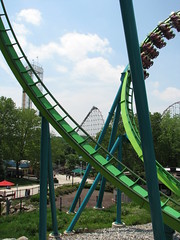 while Talon has the tighter organization, bigger dynamic contrasts and stronger G-forces throughout that make it the superior ride.
while Talon has the tighter organization, bigger dynamic contrasts and stronger G-forces throughout that make it the superior ride.
With Talon behind us we made a quick stop at the Wild Mouse which had no lines. It was pretty average for a mouse ride, and I personally thought the upper switchbacks were too wide, but the cars still hit the turns hard enough. The seats were the most awkward I’ve ever ridden as well; they must have been only 6 inches deep, I was sitting on the edge for the whole ride.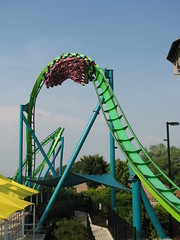
Finishing off the ‘four corners’ of the park is Dorney’s signature ride, at least signature for me in that it has no close counterparts from my home Cedar Fair park: Hydra: The Revenge. It was much smaller in person than I was expecting, the seven inversions always made me think of it as the ‘superior’ investment to Talon’s four, but Talon in fact towers over the much more demure Hydra, which thankfully has some terrain to keep this interesting. I remember when the ride was first announced to occupy the same hillside as Hercules and was going to feature something like seven tunnels I was expecting some sort of crazy terrain looper, and instead somehow Cedar Fair and B&M collectively managed to figure out how to make it feel like it’s just another ride on a flat piece of land even if it isn’t, and those tunnels clearly never saw the light of day… er, so to speak. Still, it’s got a more interesting layout, not even including the jojo roll, that manages to make do without a single vertical loop, and many of the elements (especially the cobra roll) I was very curious to see how they’d ride since their more amoebic shaping suggested B&M was really going for some interesting force-based design beyond
the seven inversions always made me think of it as the ‘superior’ investment to Talon’s four, but Talon in fact towers over the much more demure Hydra, which thankfully has some terrain to keep this interesting. I remember when the ride was first announced to occupy the same hillside as Hercules and was going to feature something like seven tunnels I was expecting some sort of crazy terrain looper, and instead somehow Cedar Fair and B&M collectively managed to figure out how to make it feel like it’s just another ride on a flat piece of land even if it isn’t, and those tunnels clearly never saw the light of day… er, so to speak. Still, it’s got a more interesting layout, not even including the jojo roll, that manages to make do without a single vertical loop, and many of the elements (especially the cobra roll) I was very curious to see how they’d ride since their more amoebic shaping suggested B&M was really going for some interesting force-based design beyond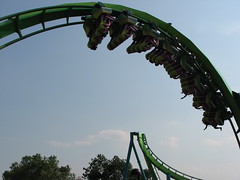 their usual elements which can be traced to some basic geometric movements.
their usual elements which can be traced to some basic geometric movements.
The ride itself is okay, but I’m not sure if I really loved the whole experience. I’m not going to jump into the whole camp dismissing the coaster as “forceless”, since A): I don’t think that’s entirely accurate, and B): that kind of stuff doesn’t matter too much to me anyway, it’s kind of like saying louder music is better than softer. But it did strike me on my first several rides that there wasn’t a whole lot of variation in sensations despite the numerous elements, and those variations that were present were muted with more drawn out, gentle transitions. A smaller scale coaster like this should find it’s excitement in fast-paced changes and other little ‘tricks’, and Hydra’s whole ‘advanced’ design seemed to be based on controlling the experience to a fault… yeah, I know, very original critique of a B&M coaster, but that’s what I saying to myself after the first couple of rides and so I must dutifully report it here.
to be based on controlling the experience to a fault… yeah, I know, very original critique of a B&M coaster, but that’s what I saying to myself after the first couple of rides and so I must dutifully report it here.
Well, the heat wasn’t helping much either, and by about this point in the afternoon the Thunder Creek Mountain log flume seemed like a good idea. Dorney’s is an interesting flume ride, it’s all a concrete trough dug in the ground, and the main drop down the side of the hill seemed to be channeling the same technology as a Slip’n’slide. It had a decently long layout and you got fairly wet despite there not being much that set it apart from other more dry flume rides. Given Cedar Fair’s tendency to cannibalize their log flumes recently I do hope this one stays around for a while.
We decided we needed to go someplace with air conditioning so we left the park to find someplace nearby to eat. I will make this one suggestion if you plan to do so: Don’t. Or at least know where you want to go and how to get there before you leave. We spent nearly an hour driving around the nearby area trying to find someplace, anyplace that seemed like a decent place to find some food. After a while we finally found a Subway, but it smelled like paint varnish in the inside and we realized we had spent so much time already looking for someplace to eat that we weren’t going to settle for a Subway just yet. Eventually we found some chain Italian restaurant, I forget exactly where, and made it back to the park by 4:30 that evening, starting with Talon and Hydra again and then making our way back over to the rest of the park. On the way we made a quick stop at the Woodstock Express, which was nicely landscaped beneath the trees, and I swear this thing might very well be the most intense ride in the park, the way the cars bounce over those little 1 ft. tall moguls. Why do people need to feel ‘guilty’ when they ride the kiddie coasters, when just riding Hydra and Woodstock back-to-back proved without question in my mind that Woodstock Express was the more extreme of the two. I don’t think we have to worry about any upstarts in the steel coaster polls, though, Woodstock Express is still far too small and one-dimensional to need to warrant a re-ride in order to appreciate it more.
and then making our way back over to the rest of the park. On the way we made a quick stop at the Woodstock Express, which was nicely landscaped beneath the trees, and I swear this thing might very well be the most intense ride in the park, the way the cars bounce over those little 1 ft. tall moguls. Why do people need to feel ‘guilty’ when they ride the kiddie coasters, when just riding Hydra and Woodstock back-to-back proved without question in my mind that Woodstock Express was the more extreme of the two. I don’t think we have to worry about any upstarts in the steel coaster polls, though, Woodstock Express is still far too small and one-dimensional to need to warrant a re-ride in order to appreciate it more.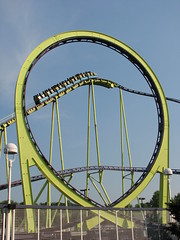
We made our way back to Voodoo with another back-seat ride. And much to my pleasure I noticed that behind it, Laser was now open. Seats are assigned but I was able to get a front-seat ride since I stayed back and let people ahead while I took pictures until the train was completely full and I would be first for the next train. The lift is very slow, which makes the high speeds that follow feel all the more surprising. For the few seconds that it lasts
with another back-seat ride. And much to my pleasure I noticed that behind it, Laser was now open. Seats are assigned but I was able to get a front-seat ride since I stayed back and let people ahead while I took pictures until the train was completely full and I would be first for the next train. The lift is very slow, which makes the high speeds that follow feel all the more surprising. For the few seconds that it lasts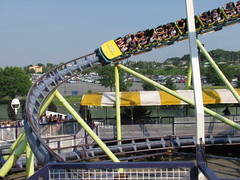 it’s a good whirlwind experience that plows through its elements
it’s a good whirlwind experience that plows through its elements like it’s in a hurry to make up for the slow lift hill and get back to the station in time. The loops are obviously the highlight of the ride, to be enjoyed without overhead restraining device to the fullest. Schwarzkopf’s compact layouts would probably be criticized if built today for being too generic and simple, but in addition to the retro-classic appeal and first-rate
like it’s in a hurry to make up for the slow lift hill and get back to the station in time. The loops are obviously the highlight of the ride, to be enjoyed without overhead restraining device to the fullest. Schwarzkopf’s compact layouts would probably be criticized if built today for being too generic and simple, but in addition to the retro-classic appeal and first-rate craftsmanship, there’s a very distinct visual beauty found in the simplicity of these designs that’s missing from most modern rides today… not counting the lime green and purple paint scheme. (The elegance of a Schwarzkopf design can’t be undone by the Cedar Fair painting department.) I’m saddened that this had to be its last season before being removed to make room for a delayed replacement Invertigo from California’s Great America, but at least it’s returned home to its original stomping grounds on the German fair circuit, where one hopes its being put to much better use.
craftsmanship, there’s a very distinct visual beauty found in the simplicity of these designs that’s missing from most modern rides today… not counting the lime green and purple paint scheme. (The elegance of a Schwarzkopf design can’t be undone by the Cedar Fair painting department.) I’m saddened that this had to be its last season before being removed to make room for a delayed replacement Invertigo from California’s Great America, but at least it’s returned home to its original stomping grounds on the German fair circuit, where one hopes its being put to much better use.
Nearby the Laser were a couple more children’s coasters I figured I should try as long as I was in the neighborhood. The Little Laser didn’t take adult riders so I was out for the count on that one. However, the Dragon Coaster on the plot next to it, despite appearances of being about as large as the Little Laser, actually had a rather curious inverse of the policy, in which a minimum height was required but no maximum. But before I could get my dirty credit I walked into an on-going debate between a Spanish-speaking mother with two small children wanted to ride, and the operator who was trying to tell her that one of her children was too young to ride. This was okay with her, but her ever-so-slightly elder daughter was tall enough to ride, but only with an adult; and this turned out to be surprisingly difficult to communicate when no language is shared. Having taken two semesters of Spanish in high school I should have been more useful than I was (all the key words I needed to get the gist of the explanation across could momentarily not be retrieved from my in-brain Spanish dictionary), but eventually we worked it out that I could be the adult accompaniment while she stayed behind with her toddler to watch. You see… if you skip the dirty credits you could also potentially be skipping
and this turned out to be surprisingly difficult to communicate when no language is shared. Having taken two semesters of Spanish in high school I should have been more useful than I was (all the key words I needed to get the gist of the explanation across could momentarily not be retrieved from my in-brain Spanish dictionary), but eventually we worked it out that I could be the adult accompaniment while she stayed behind with her toddler to watch. You see… if you skip the dirty credits you could also potentially be skipping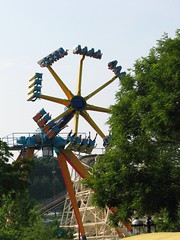 out on all kinds of fun, multicultural experiences?
out on all kinds of fun, multicultural experiences?
The Revolution, a Chance-Morgan spinning pendulum ride along the far back pathway between Laser and Steel Force, was another ride that I tried, as generally I find flat rides of this variety reasonably enjoyable, and that is the case here provided you’re able to sit on an arm that tends to spin on the upper side of each swing rather than the lower side. I also later did the Dominator, a drop ride from S&S composed of three towers, each with a different ride experience. The blue side slowly takes you up 170’ and then drops
pathway between Laser and Steel Force, was another ride that I tried, as generally I find flat rides of this variety reasonably enjoyable, and that is the case here provided you’re able to sit on an arm that tends to spin on the upper side of each swing rather than the lower side. I also later did the Dominator, a drop ride from S&S composed of three towers, each with a different ride experience. The blue side slowly takes you up 170’ and then drops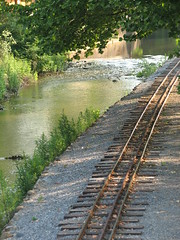 you down faster than freefall, the ride side launches you up and back down at 50mph, and the white side lets you look at it at 0mph and speculate if Dorney Park will ever add any hardware to it. I did the red side as the shorter duration meant higher capacity meaning I only had to wait one cycle. As always I was pretty jaded towards it, the main entertainment value being the histrionic
you down faster than freefall, the ride side launches you up and back down at 50mph, and the white side lets you look at it at 0mph and speculate if Dorney Park will ever add any hardware to it. I did the red side as the shorter duration meant higher capacity meaning I only had to wait one cycle. As always I was pretty jaded towards it, the main entertainment value being the histrionic expressions of the girl seated next to me.
expressions of the girl seated next to me.
The last ride my dad and I did together before he returned to the car for a late afternoon rest and to listen into a ball game was the Thunderhawk, Dorney Park’s 1923 Herb Schmeck wooden roller coaster. In a state rich with classic wooden roller coasters the Thunderhawk unfortunately feels like the most unnecessary. In fact, of all the classic, pre-war wooden roller coasters I’ve been on,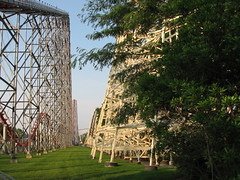 this one feels the least like a classic and the most like a badly maintained, early 1980’s Dinn creation that would otherwise have legions of enthusiasts online yelling ‘taer it down’ had the name Schmeck not been attached to it. Instead people look at it in pity and comment how all those trim brakes are a waste, why can’t Cedar Fair properly maintain their wooden roller coasters, etc.
this one feels the least like a classic and the most like a badly maintained, early 1980’s Dinn creation that would otherwise have legions of enthusiasts online yelling ‘taer it down’ had the name Schmeck not been attached to it. Instead people look at it in pity and comment how all those trim brakes are a waste, why can’t Cedar Fair properly maintain their wooden roller coasters, etc.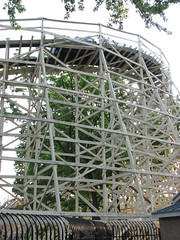
Structurally the coaster appears to be in tip-top condition, it’s mostly a combination of the rolling stock (stiff, lugubrious PTCs with hard seats and tall headrests) and a penchant for trim brakes that figuratively and literally hold the ride back. The best place to sit is the front row, as it both tracks the smoothest and gets the most airtime (most of the big hills have a wide, descending curve on the way down), besides simply giving the best visceral experience. Be forewarned that you will likely not be the only person in the park to figure this out, as more often than not the air gates for the front half of the train will fill up first and even get multi-train waits before the back rows are taken. The layout is basically
that figuratively and literally hold the ride back. The best place to sit is the front row, as it both tracks the smoothest and gets the most airtime (most of the big hills have a wide, descending curve on the way down), besides simply giving the best visceral experience. Be forewarned that you will likely not be the only person in the park to figure this out, as more often than not the air gates for the front half of the train will fill up first and even get multi-train waits before the back rows are taken. The layout is basically an out-and-back bent into a fishhook configuration (which means more laterals and less airtime), the main unique feature being the descending curve drops which weren’t as common in older designs, and unfortunately seem to give the most problems with tracking. There’s one very flat, triangular bunny hop on the out run that doesn’t provide much airtime; most out-of-your seat experiences will be had at the crests of the high turnarounds. To the hawk’s credit it does get a bit of a lively pace going, which is then quietly killed on the return run with a series of very un-quiet trim brakes.
an out-and-back bent into a fishhook configuration (which means more laterals and less airtime), the main unique feature being the descending curve drops which weren’t as common in older designs, and unfortunately seem to give the most problems with tracking. There’s one very flat, triangular bunny hop on the out run that doesn’t provide much airtime; most out-of-your seat experiences will be had at the crests of the high turnarounds. To the hawk’s credit it does get a bit of a lively pace going, which is then quietly killed on the return run with a series of very un-quiet trim brakes.
I know that the park knows that people (not just enthusiasts) complain about these brakes, and I can’t imagine any of their managers ride Thunderhawk and think to themselves, “wow, this is the sort of attraction we’re proud to be earning people’s hard-earned vacation dollars for,” so there’s either a lack of knowledgeable expertise in their maintenance department or a lack of corporate structure to allow them to get money budgeted for these sorts of ‘miscellaneous’ projects, but this ride need help soon. And no, I don’t mean they need to do one of those multi-million dollar complete revamps with hybrid technology and on-board music kind of crap.
“wow, this is the sort of attraction we’re proud to be earning people’s hard-earned vacation dollars for,” so there’s either a lack of knowledgeable expertise in their maintenance department or a lack of corporate structure to allow them to get money budgeted for these sorts of ‘miscellaneous’ projects, but this ride need help soon. And no, I don’t mean they need to do one of those multi-million dollar complete revamps with hybrid technology and on-board music kind of crap.
With a couple of hours on my own before my dad rejoined me for last night rides I decided I would explore more of the center of the park, with its winding pathways hiding a diverse array of family and flat rides between trees and gardens. Since this area is built on a hill and with few major attractions of note it tends to be skipped by most thrill-seekers who stick to the major pathways along the outside lowlands where all the big new coasters have been installed, which is quite a shame. Certainly if one has been to any of Pennsylvania’s numerous other quirky, homespun amusements even this area may feel disappointingly corporate, but to find an original 1920-built Whip among other rides tucked away amid the generic carnival-colored steel monsters that make up the landscape of any other Cedar Fair park did come as a more than pleasant surprise. Admittedly apart from the Zephyr train ride along Dorney Creek, most of the other rides here are of the post-1970’s variety, but the charm is still there and I think Dorney Park’s management is smart enough to know not to mess with these areas too much.
Since this area is built on a hill and with few major attractions of note it tends to be skipped by most thrill-seekers who stick to the major pathways along the outside lowlands where all the big new coasters have been installed, which is quite a shame. Certainly if one has been to any of Pennsylvania’s numerous other quirky, homespun amusements even this area may feel disappointingly corporate, but to find an original 1920-built Whip among other rides tucked away amid the generic carnival-colored steel monsters that make up the landscape of any other Cedar Fair park did come as a more than pleasant surprise. Admittedly apart from the Zephyr train ride along Dorney Creek, most of the other rides here are of the post-1970’s variety, but the charm is still there and I think Dorney Park’s management is smart enough to know not to mess with these areas too much.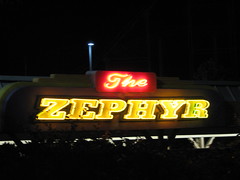 It’s just a matter of can the classic charm remain congruous
It’s just a matter of can the classic charm remain congruous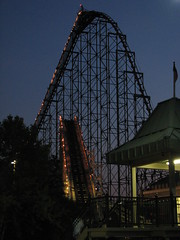 with the modern thrills so Dorney Park doesn’t have quite as fractured an identity? That is a formula I don’t think they’ve yet managed to concoct, disappointing when other parks like Kennywood have excelled at bringing themselves into the 21st century without losing their charm, but then again not surprising given that these are the same people that
with the modern thrills so Dorney Park doesn’t have quite as fractured an identity? That is a formula I don’t think they’ve yet managed to concoct, disappointing when other parks like Kennywood have excelled at bringing themselves into the 21st century without losing their charm, but then again not surprising given that these are the same people that  brought us the Dominators, Intimidators, Xcelerators, the Forceless Forces and enough bird-of-prey themed rides to make a National Audubon Society member giddy.
brought us the Dominators, Intimidators, Xcelerators, the Forceless Forces and enough bird-of-prey themed rides to make a National Audubon Society member giddy.
 To close out the Sunday evening I did an hour-plus long marathoning session on Hydra, which was always a walk-on (at least if you’re a single rider who doesn’t mind not always getting preferential seating).
To close out the Sunday evening I did an hour-plus long marathoning session on Hydra, which was always a walk-on (at least if you’re a single rider who doesn’t mind not always getting preferential seating).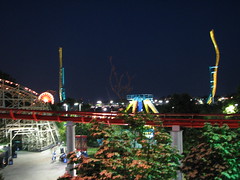 My opinion of the coaster improved markedly after this. It’s easy to ride ad infinitum without getting sore or burned out, but the variety of elements keeps it interesting enough to keep from getting bored by its one-dimensionality. The layout after the cobra roll still kinda sucks when it shouldn’t (there are two chances for airtime in a row,
My opinion of the coaster improved markedly after this. It’s easy to ride ad infinitum without getting sore or burned out, but the variety of elements keeps it interesting enough to keep from getting bored by its one-dimensionality. The layout after the cobra roll still kinda sucks when it shouldn’t (there are two chances for airtime in a row, why do moments that should be completely forceless feel so forced?) but when
why do moments that should be completely forceless feel so forced?) but when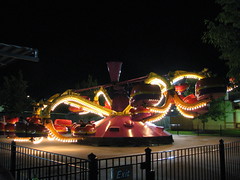 I got sick enough of that there was always Talon nearby to remedy things. I was partly surprised that a big corporate park not far from several major metropolitan areas could be so lightly attended on a weekend evening. I figured once the water park closed the coasters would be bottlenecked but that never happened. In fact, it got so light that just before my dad returned I became the only person waiting on the entire Talon
I got sick enough of that there was always Talon nearby to remedy things. I was partly surprised that a big corporate park not far from several major metropolitan areas could be so lightly attended on a weekend evening. I figured once the water park closed the coasters would be bottlenecked but that never happened. In fact, it got so light that just before my dad returned I became the only person waiting on the entire Talon loading platform. That’s nuts! And
loading platform. That’s nuts! And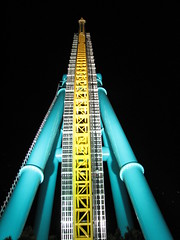 awesome…
awesome…
We finished the evening with another lap on Thunderhawk and then several more Steel Force rides in the dark, which for whatever reason had a longer line than the Beemers. We considered doing more Hydra but I knew Laser was on its way out after this season so we opted to make that our ultimate Dorney Park coaster, and it was a good choice. They actually had to close it all of five minutes before it was supposed to shorting us on one reride due to lightning in the area; I did indeed observe some rather eerie, silent heat lightning to the east. We collected several more photos of the illuminated park grounds before making our exit stage right.
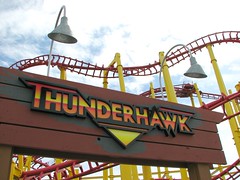

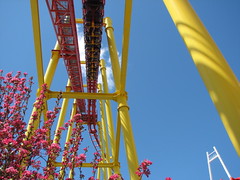
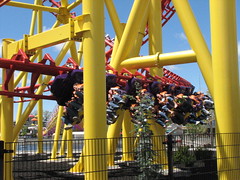


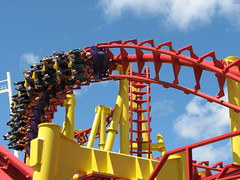
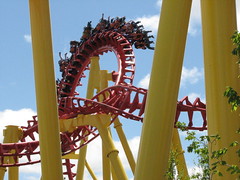
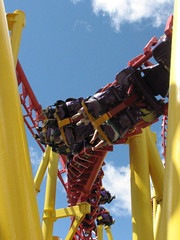
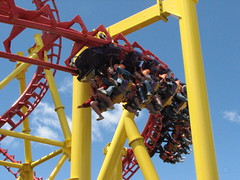


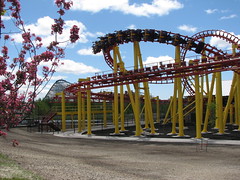
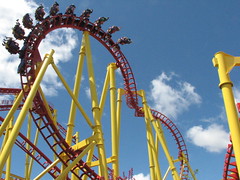

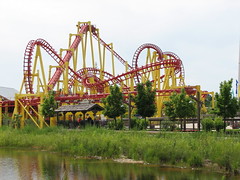
Comments